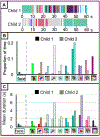Gaze in Action: Head-mounted Eye Tracking of Children's Dynamic Visual Attention During Naturalistic Behavior
- PMID: 30507907
- PMCID: PMC7262731
- DOI: 10.3791/58496
Gaze in Action: Head-mounted Eye Tracking of Children's Dynamic Visual Attention During Naturalistic Behavior
Abstract
Young children's visual environments are dynamic, changing moment-by-moment as children physically and visually explore spaces and objects and interact with people around them. Head-mounted eye tracking offers a unique opportunity to capture children's dynamic egocentric views and how they allocate visual attention within those views. This protocol provides guiding principles and practical recommendations for researchers using head-mounted eye trackers in both laboratory and more naturalistic settings. Head-mounted eye tracking complements other experimental methods by enhancing opportunities for data collection in more ecologically valid contexts through increased portability and freedom of head and body movements compared to screen-based eye tracking. This protocol can also be integrated with other technologies, such as motion tracking and heart-rate monitoring, to provide a high-density multimodal dataset for examining natural behavior, learning, and development than previously possible. This paper illustrates the types of data generated from head-mounted eye tracking in a study designed to investigate visual attention in one natural context for toddlers: free-flowing toy play with a parent. Successful use of this protocol will allow researchers to collect data that can be used to answer questions not only about visual attention, but also about a broad range of other perceptual, cognitive, and social skills and their development.
Conflict of interest statement
Disclosures
The authors declare that they have no competing or conflicting interests.
Figures





References
-
- Hayhoe M Vision using routines: A functional account of vision. Visual Cognition. 7 (1–3), 43–64 (2000).
-
- Land M, Mennie N, & Rusted J The Roles of Vision and Eye Movements in the Control of Activities of Daily Living. Perception. 28 (11), 1311–1328 (1999). - PubMed
Publication types
MeSH terms
Grants and funding
LinkOut - more resources
Full Text Sources
